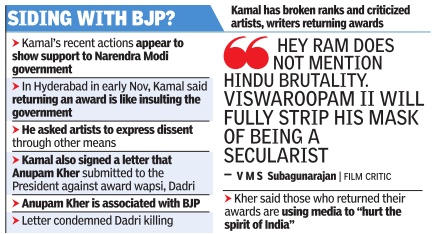Kamal Haasan
This is a collection of articles archived for the excellence of their content. |
His rightward shift
The Times of India, Nov 19 2015
M Kalyanaraman & Abdullah Nurullah

Viswaroopam, stance on Award Wapsi have given saffron shade to Leftist image
Movies were as much a part of Sivagiri's life as any Tamil's. A resident of Ramanathapuram, he identified with Kamal Haasan's `Thevar Magan' released in 1992. A proud Thevar, Sivagiri felt that Kamal, whose roots were in nearby Paramakudi, had accurately depicted Thevar men born to rule and proud bearers of village values. But Sivagiri also felt that the film was subversive. It showed a mirror to Thevars, asking them to move on, get educated and leave behind their old conflicts. Critics at that time took umbrage at Thevar Magan's sympathy for feudal values. But such `insider' movies were becoming Kamal's hallmark. In `Michael Madana Kamarajan', the most convincing character that Kamal portrays is that of a Palghat Brahmin cook. Through the innocent, even naïve, Kameswaran, Kamal portrayed a community its foibles, claustrophobic existence and its preference for shutting itself off from society .An insider view and a gentle critique, yet again.
Many, however, see a turning point in `Hey Ram' released in 2000. “In that movie, he portrays the brutal raping and killing of a Hindu woman by a Muslim gang during the pre-independence Calcutta riots. The scene is gory but there is no mention of brutality by Hindus,“ says V M S Subagunarajan, a noted film critic.
While portraying how Saket Raman was provoked, Hey Ram also advised a Gandhian restraint for him, asking him to see the best in the `other'. But many think that in his quest to get inside the skin of a character, Kamal had tipped over in Hey Ram.
The movie had come after several years during which Kamal was publicly advocating communal peace, if not secularism. As vice-president of Harmony India, he spoke against the BJP's ideas in the 1990s -when the party was ascendant. Pralayan, a theatre activist, recalls that after the Babri Masjid demolition in 1992, Kamal met with then Prime Minister Narasimha Rao to share his concerns over rising communal tensions in society . society.
In Kerala, Kamal Haasan participated in literary events sponsored by the CPM. Three years after Hey Ram, Kamal came back with ` Anbe Sivam'. The film's central character was akin to Pralayan whose forte is street theatre. Leftist in its atmospherics, the film nevertheless advocates forgiveness activism without bitterness or hate.
Some left-wingers continue to be charitable to Kamal. Gnani, a political analyst, points to Kamal's stand on the beef issue. “Kamal has said that people are free to eat what they wish,“ he says, but adds that while Kamal is free to take a stand on the issue of artists and writers returning awards, he should not have ridiculed those who did so.
Other left-wingers still him as their man but are worried. “Kamal's recent films seem to indicate a different trajectory . Not sure if he is reading something new, making new friends or what but there seems a change in his choice of subjects for films,“ says Kavin Malar, a Tamil writer.
Meanwhile, Kamal has been in the news meeting religious leaders. He recently met with Sri Sri Ravi Shankar and before that the Nanguneri Vanamamalai Jeer. He supported Anupam Kher's virulent campaign against `award wapsi' and met with Raj Thackeray .
Subagunarajan says that Kamal was always a closet right-winger, he says.Though born into a Brahmin family , Kamal had positioned himself as a rebel, rationalist and a follower of Periyar in his early days. But Subagunarajan dismisses that as just posturing in a state dominated by Dravidian politics, if not ideas. “In `Viswaroopam', Kamal spent the greater part of the film portraying Muslims as extremists. I believe Viswaroopam II will fully strip his mask of being a secularist,“ he says.
Those who know Kamal personally , however, decry attempts to slot him.They see him as a truth-seeker who tries to understand various viewpoints fully .“Kamal's search for meaning has never stopped. It is an ongoing quest. He has never restricted himself in a circle as far as political preferences go. He is always open to new ideas (thoughts) and new people. I see his meetings with rightwingers as only a part of his quest to be inclusive and accommodating of different beliefs. He has never shied away, never hid his intentions or beliefs,“ says Santhana Bharathi, an actor, director and friend of Kamal Haasan.
It may well be that Kamal Haasan, like many artists, reacts at a visceral and emotional level to the issues of the day without sticking to frameworks. Just as he loves image-transforming make-up, Kamal is comfortable donning many roles in public roles that may not necessarily harmonize. In the end, he may just be like most people playing many roles in life but stricken by a looming anxiety over whether they have an inner core that is constant at all.